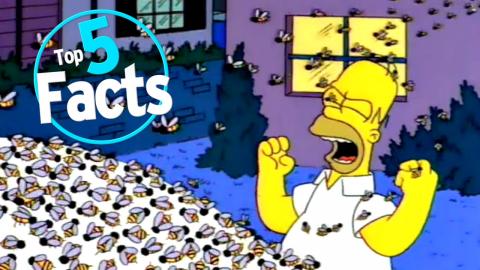Top 5 Facts about Bees

Ever feel like you're just a mindless worker slaving away day in and out just to keep a roof over your head? Welcome to WatchMojo's Top 5 Facts. In this instalment, we're counting down the five most intriguing facts about your friendly neighbourhood honey bee (but not those super badass Africanized ones).
Special thanks to our users Godslayer79 and Trevor Hay for submitting the idea using our interactive suggestion tool at http://www.WatchMojo.comsuggest
WMFacts: Top 5 Facts: Bees
Ever feel like you’re just a mindless worker slaving away day in and out just to keep a roof over your head? Welcome to WatchMojo’s Top 5 Facts. In this instalment, we’re counting down the five most intriguing facts about your friendly neighborhood honey bee (but not those super badass Africanized ones).
#5: Bees Can Reverse Age Their Brains
Ever feel like old age has suddenly crept on you? Researchers think bees may hold the key to reversing the inevitable effects of aging. Generally, old bees forage for food while young bees take care of the larvae. However, when scientists tricked old bees into doing the work of young bees, they found something interesting. After just a week of performing the more gregarious activity of caring for baby bees, the older bees showed a dramatic change in their brain chemistry. Not only did they increase their ability to learn new things, but proteins were found in their brains that are known to combat debilitative diseases like Alzheimer’s in humans. While any medication from these findings is in the distant future at best, researchers suggest simply taking part in more social activities may give ours brains jump start towards rejuvenation.
#4: Bee Venom Is Joining the Fight Against AIDS
In 2013, scientists at the Washington University School of Medicine in St. Louis designed a way to attack HIV cells using a powerful toxin present in bee venom. The toxin, melittin, is loaded onto nanoparticles and has proven effective at fighting a range of viruses, such as HIV, and even on tumors. The secret is it’s size. The nanoparticles are so small that they bounce right off of normal, healthy cells. Conversely, when they come into contact with a virus, which are much smaller than the particles themselves, they poke holes into the protective envelopes around the virus. This enables the body’s own immune system to fight it off. Researchers are hopeful this could lead to a preventive AIDS vaccine, as well as a treatment for current AIDS patients.
#3: Caffeine Makes Great Worker Bees; Cocaine Makes Great Liar Bees
Most college students have pulled their fair share of caffeine-fueled all nighters, but they aren’t the only ones. Studies show that caffeine actually improves the memory of bees. This is an advanced adaptation by plants which encourages pollinators, such as bees and butterflies, to make return visits. This provides the insects with food and the plants with a way to distribute their pollen. Win-win! On the other hand, cocaine may provide the illusion of doing a great job, but don’t be fooled. When provided with cocaine, bees experienced a very familiar “high” effect. It excited them to the point of what you may call lying -- when dancing to inform other bees of a food source, their movements became exaggerated and the quality of the food was overstated.
#2: Bees Might Be Smarter Than You
Though a bee’s brain is only about the size of a grass seed, they’re able to accomplish some pretty amazing things. While the dance bees use to communicate may not look like much, it’s actually the most complicated use of language by an animal outside of the primate family. Their bee boogie is able to relay specific, detailed information about the location and quality of food. The language is so complex that Karl von Frisch won a Nobel prize in 1973 just for deciphering it. In addition, bees can easily solve a math problem that stumps people – and some computers. The “traveling salesman problem” involves finding the shortest possible route between a large number of locations, and bees are naturals at it. No matter what order flowers are found in, bees always know the shortest way to get to all of them.
#1: It Takes a Lot to Make Honey, Honey
For a hive to survive over the winter, it needs to have anywhere between 20 and 90 pounds of pounds of honey, depending on its size, the climate, and other factors. That may seem like a lot, but during the busy summer months, a hive may be home to up to 60,000 bees. They need that many bees, because a typical honey bee will create only one twelfth of a teaspoon in their entire lifetime. That’s less than half milliliter each. To produce a 12-oz bottle of honey, it would take 288 bees working full-time all the way until they die. So, the next time you drizzle honey over something, reflect on all the hard work and sacrifice that went into making it. And just in case you were wondering, honey is made from flower nectar that bees eat, regurgitate, eat, and repeat. Enjoy your peanut butter a bee vomit sandwich!
So, does that revelation change your opinion about honey? For more bee-autiful top 10s and barf-tacular top 5s, be sure to subscribe to WatchMojo.com
